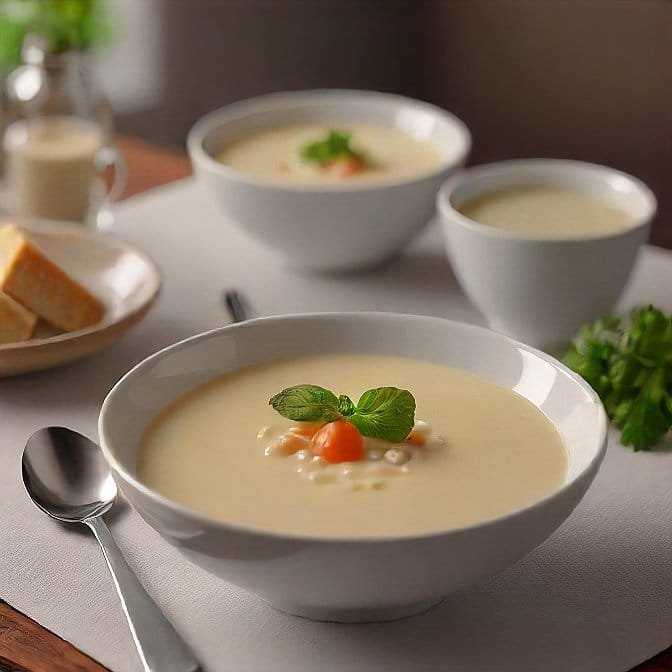Table of Contents
Introduction
Among the few things that are truthfully comforting, cream soup is a perfect comfort or solace. If one needs something light yet satisfying, it might be a chilly evening, or it could be whatever reason, but few soups can still match the promises of rich and indulgent experiences. Rich, deep flavorings and velvety textures make these soup kitchen staples. Delicious, they are also very versatile-they can be adapted easily to whatever may be on hand; and from weeknight dinner to special occasion dinner, these soups will hit the spot.
This will lead us down the rabbit hole of cream soup, discovering what makes them special, recipes, and even tips in case your cream soups do not turn out just perfect. We will also take a look at the variations and some serving ideas that will be able to upscale your soup game, along with giving it a twist to a classic dish.
What Are Cream Soups? A Deliciously Smooth Introduction

Soups are also categorized as cream soups. The cream soups have richness, smoothness and everything creamy texture: Unlike the broths, the creamy soups typically use milk or cream as the main liquid and either flour or roux to thicken it and the result is silky smooth. That process will give soup the characteristic velvety mouthfeel as well as the depth of flavor to conquer most taste buds.
Traditionally, creamy soups start out with a foundation of vegetables or proteins such as mushrooms broccoli, or, indeed chicken. The ingredients then cook and puree well to ensure they combine nicely with the creamy base in a pleasant harmony of flavors. Cream soups can be pureed to silky smoothness or just a touch chunky.
These soups are versatile and can be found in a variety of forms across international cuisine. Whether you are indulging in a true French cream of mushroom soup, a heaping creamy chicken, or an easy, uncomplicated cream of tomato soup, these come to deliver comfort with satisfaction at minimum effort to your table.
Classic Cream Soups You Must Try
There are extremely many cream soup recipes that make different flavors and textures. Cream soups can be derived almost from any vegetable or protein, but several have managed to stay through the ages as classics. Try these popular cream soups:
- Cream of Mushroom Soup:
A true classic, cream of mushroom soup is adored for its rich earthy flavor. It’s a rich, savory super soup that is full of umami and made with mushrooms like cremini, button, or wild mushrooms. By sautéing those mushrooms in butter, you are really coaxing out their own flavors just right along with fresh herbs such as thyme to add that little something special. Heavily, it is often used as a base for other casseroles, but it stands alone so well. - Cream of Broccoli Soup:
It’s rich, green, and full of nutrients and flavor; cream of broccoli is ideal for the vegetable lover who enjoys fresh flavor. The item is cooked in broth and then pureed with a hint of cream to silky smoothness. Some recipes go as far as to add a small amount of cheese-dwed commendable with cheddar or Parmesan-for an acidic twang. Cream of broccoli appears to be a healthy, savory soup that is certainly satisfying. - Cream of Chicken Soup:
Surely, the cream of chicken soup is one of the most classic dishes that has wholesome, hearty richness; it can be dished out on its own or used as a base for many other dishes. Shredded chicken mixed into a rich creamy broth makes a hearty soup that’s just right on a cold day. It is quite often flavored with celery carrots and onions for a completely nutritious dish. Serve this along with crusty bread for an autumn cozy meal. - Cream of Tomato Soup:
Simple and delicious, the cream of tomato soup is a favorite due to its bright tangy flavor combined with the richness of the cream. The tomatoes are simmered with the onions, garlic, and basil, to make it smooth. The cream is added towards the end to balance everything amazingly well. It’s often taken many times with a grilled cheese sandwich for that perfect comfort food.
Of course, you will find a thousand rich creamy soups that widely and wildly excite someone over the palatability, but again and again, you become lost in the number of combinations. Creativity will make close to any vegetable or protein yield a rich, full-bodied cream soup.
How to Make the Perfect Cream Soups: A Basic Recipe Template
While ingredients and flavor profiles for each cream soup may be unique, in practice they all work the same way. Once you’ve learned this basic template, you can easily create a whole range of cream soups.
- Step 1: Sauté Your Vegetables or Proteins
- Prepare the cream soup: First, cook your base ingredients. Mushrooms, broccoli, and chicken seem better for having been sautéed in butter or oil with this delicious richness liberated. That’s also a good time to add aromatics of onions, garlic, or leeks to depth.
- Step 2: Create a Roux or Add Flour
- Most cream soups rely on a roux-or just a dusting of flour-for that silky, luscious texture. Toss in your flour with your softened vegetables or proteins and cook for a minute or two to thicken and add body to the soup.
- Step 3: Add Broth or Stock
- Then you add your broth or stock. Use chicken, vegetable, or beef broth according to your soup. This tends to cook the vegetables and proteins a bit more but starts to thicken the base of the flavor of the soup.
- Step 4: Simmer and Blend
- Then add the liquid and bring to a simmer. Let this cook until the veggies are soft, and all the flavors have melded together. Then you may puree the soup into whatever consistency you want; some want totally smooth, while others like a few chunks for a heartier feel.
- Step 5: Stir in Cream
- Finally, return the soup to low heat and add the cream. You will need to whisk the cream into the soup but don’t cook it as the cream will curdle when there is cream. That is where you can season it up with any additional flavorings or fresh herbs should you want it.
Best Ingredients for Luxurious Cream Soups
The quality of your ingredients can either make or break a cream soup. Below are some of the main ingredients that will help you recreate the luxurious taste of a restaurant-standard result:
- Vegetables: Most cream soups require fresh vegetables. Whichever cream is that you are making, be it asparagus or cauliflower, then you should use fresh produce so that you have a dish with bright flavors and smooth textures. Among the best vegetables used for cream soups include mushrooms, broccoli, potatoes, carrots, and tomatoes.
- Cream: The cream you are going to use will be how you make your soup thicker and richer in texture. Using heavy cream, you will get the richest and creamiest texture possible. For a lighter version, half-and-half or even whole milk will do. If you want to make it dairy-free, you can use coconut milk, cashew cream, or almond milk instead.
- Broth or Stock: Quality broth is the origin of a developed flavor base. Choose your broth based on your soup, be it chicken, beef, or vegetable. Freshly made homemade stock, if at all possible, is the best. Still, store-bought stock can be used for any situation when this is not possible.
- Butter: The butter is added to this stage in order to give the cream a richer flavor, especially when browning the ingredients of the soup while sautéing. If you are vegan, you can add olive oil or plant-based butter.
- Herbs and Spices: Whatever is too overpowering for your cream soup’s main ingredient depends on the seasoning. On the other hand, fresh herbs like thyme, parsley, basil, or dill will be added to it, and spices such as nutmeg, smoked paprika, or black pepper will make it warmer with a heavier flavor.
Check Out: Rich & Velvety Mushroom Cream Soup: A Must-Try Comfort Recipe.
Delicious Variations: Customizing Your Cream Soups

Another reason cream soups are quite pleasing is because they can easily be customized to suit any taste. Different ingredient combinations and testing different flavors would result in new, scrumptious, and lovely variations that cater to the personal or individual’s taste buds or dietary needs.
- Dairy-Free and Vegan Cream Soups: If you dislike to drink milk, don’t worry because there are still excellent options for making creamy soups as milk and cream substitute with other ingredients. Coconut milk adds richness and luxurious texture as well as just the slightest hint of sweetness. It is divine in cream-of-carrot or sweet-potato soups. Another brilliant stand-in is cashew cream: all you have to do is soak cashews in water and puree, to a silky paste, for an elegantly conceived addition to add to your soup. Almond milk, by contrast, is a lighter option suited to light soups, such as cream of asparagus.
- Adding Protein: Cream soups can be magnificent on their own, but adding protein makes them a satisfying meal. Shredded chicken, sautéed shrimp, or chopped tofu adds bulk without overpowering the sweet flavors of the soup. For a heartier cream of potato soup, stir in crumbled bacon or ham.
- Playing with Vegetables: Where your classic cream soups feature mushrooms, broccoli, and tomatoes, for goodness’ sake, there’s nothing that says you can’t branch out. Cream of zucchini, cauliflower, or roasted red pepper soup creates new and interesting flavors and textures. Don’t fear mixing it up with season-specific vegetables to create fresh and unique soups throughout the year.
- Herb and Spice Infusions: Adding fresh herbs and spices will give your cream soup a boost of depth. Oregano with red pepper flakes can make a cream of tomato soup taste Mediterranean, and ginger and lemongrass in an Asian version can be mouth-numbingly spicy, ending bright and zesty.
Pro Tips for Making Restaurant-Quality Cream Soups at Home
Now, as for the cream soups, it cannot be said that it is very complicated, but several little tricks will make the dish considerably more exquisite.
- Prevent Curdling: Reducing the Proteins The next thing that may go wrong with the cream soups is curdling eg curdling of milk, cream, or even any other ingredients containing proteins. This can easily be prevented by heating the cream properly and then taking careful non-boiling of the soup after adding the cream. This is also eased by adding a little warm soup to it before pouring it into the larger pot for the final mixing.
- Avoid Over-Thickening: Cream soups are rich and thick, not too thick, though. And if it does get a little too thick, then simply add a tiny bit of broth or water to thicken it up again. Anyhow, it’ll thicken a little as it cools down to room temperature. Prepare accordingly-thinner.
- Layer Your Flavors: Building flavor is the critical aspect of a good cream soup. Start with cooking aromatics like onions and garlic, then deglaze with a splash of white wine or vinegar to add a little more depth; season soup with salt, pepper, and fresh herbs as you go, building it up layer by layer, so the flavors have time to develop in harmony.
Serving Ideas for Cream Soups
A cream soup is best in a place where a presentation and pairing will make a difference. Here are some ideas that may make your cream soups even more enjoyable:
- Garnishes: This is a soup that only needs a few well-chosen garnishes to be a more adult soup. Croutons, crispy bacon, grated Parmesan, fresh chives or parsley, etc, add the picture value and textural as well as taste value. Finally, indulge with a little truffle oil or a splash of extra cream at the end.
- Bread Pairings: Serve creamy soups with this warm, crusty bread. Consider sourdough baguette, garlic bread, or even just a piece of whole-grain toast. Crunchy bread must accompany scoop every last drop of creamy soup.
- Serving at Parties: Serve cream soups as an appetizer. Using small bowls or cups, especially for dinner parties, provides a way for the guests to begin with a soup course, not full enough to enjoy all the other dishes.
Conclusion: Why Cream Soups Deserve a Place in Your Recipe Book
It is a powerful convenience food that every home cook should master incredibly versatile comfort food, from the most casual weeknight dinner to holidays and events. Of course, that is possible with the right fresh ingredients, perfect techniques for a creamy texture, and experimenting with different flavors-restaurant-quality soups have never been easy to reproduce at home.
Whether it is a classic cream of mushrooms or an experiment with some new variation, you will realize that cream soups are bound to satisfy a perfectly nourishing and indulgent meal. All you need to do is pick your favorite vegetables, add the best quantity of cream to the pot, and there you have it – a nice warm velvety bowl of something just delicious.
For more details: Click Here.
FAQs
Can I freeze cream soups?
Yes, cream soups can be frozen. Be sure to freeze all the soups before. Finally, while serving, thaw the soup and add in the cream when reheating, this prevents curdling of the cream.
How do I prevent my cream soup from curdling?
This will prevent curdling and also warm the soup gently. Do not allow it to boil strongly when you pour in the cream. Temper the cream: Mix a little warmed soup with the cream before pouring it into the pot.
What can I do if my cream soup is too thick?
If your cream soup turns out to be too thick for your taste then do not fret- it can be thinned with broth or water or even milk. We might only stir the soup enough so that it warms through and the soup is smooth and should there be some lumps then they should dissolve in the soup.
